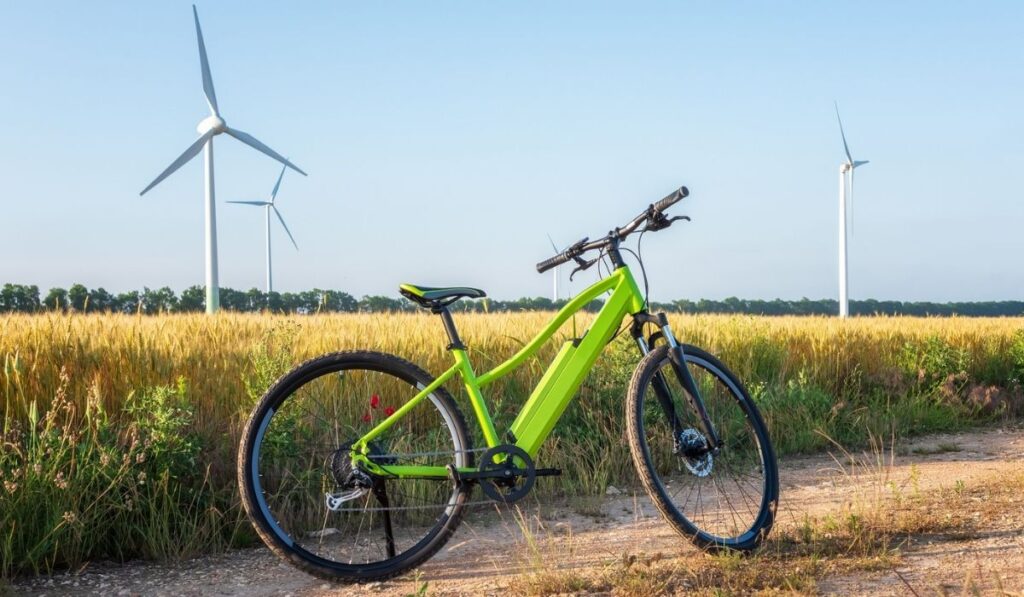E-bikes are a great way to get around without needing to power everything yourself. In terms of sustainability, however, there is a lot to digest when comparing e-bikes to other forms of transportation. Diving into the topic, you’ll find a lot of information that paints a grim picture for the planet. In the end, all we want to do is help the earth as much as possible. So the question is, are e-bikes a good way to do that? Are they sustainable in the long run?
E-bikes are one of the most sustainable forms of transportation. While e-bike carbon emissions (manufacturing and transport) are not zero, there is no contest when compared to cars. With less carbon produced per mile and great battery capacity, e-bikes are much better for the environment in the long run.
If you are looking for a sustainable way to get to work, the store, or just around town, the e-bike is a great option. If you truly want to reduce your carbon footprint to zero, however, you may have to stick to commuting by foot. The reality is that traditional bikes, cars, scooters, skateboards…they all put carbon into the atmosphere during some stage of production. So how do e-bikes fare in this sense? We’ve got all that information and more; just read on!
The Life Expectancy of an E-Bike

We all want to find transport that’s going to last a decent amount of time before it needs replacing; better for the Earth and for our wallets. Since you’ll have to fork over some dough for the extra power, one question on your mind might be how long is this investment going to last? On that front, there are a few things you’ll need to consider when determining the lifespan of a typical new e-bike.
Generally speaking, you can expect a good ten years of service from your e-bike. This will of course change depending on the quality of the bike, how you use it, and how you care for it. In most cases, a good-quality e-bike can last a while, but you may have to replace some parts along the way.
When it comes to what factors define an e-bike’s life expectancy, you will see some of the usual suspects when it comes to bike components. The additional parts that make it an e-bike, like the motor, battery, and others, also come into play. Generally speaking, though, you’ll be replacing regular bike parts like brake components and chains long before you’ll need to worry about things like motor maintenance.
In this regard, the motor type will help indicate how long you can expect to use your e-bike before it needs replacing. Usually contained motor types, like the mid-drive models, give you the most protection when it comes to a sealed-off design. For motors that have more exposed parts, dirt, and grime can get in easier, affecting the overall lifespan of the part.
How Long Do E-Bike Batteries Last?
The crucial element of your e-bike that you’ll need to manage is the battery. In most cases, battery type and size is going to be the biggest factor that affects lifespan and overall usability. The higher the quality of the battery you choose, the better your chances of elongating your bike’s lifespan.
Most e-bike batteries are high-quality lithium-ion, meaning manufacturers build them to last. On average, you can get around 1000 charge cycles out of a battery. Things like heat exposure and constant charging, however, can widdle this number down.
It’s worth taking a moment to explain what we mean by cycle. Consider your battery is at 100%. If it gets down to 70% and you charge it back up, that’s only 30% of a cycle. A full cycle is a full charge or going from 0% to 100%. This means that the number of times you charge it isn’t as important as the number of cycles you’ve gone through, so keep that in mind.
One last thing to mention is heat. Since your bike is out and in the elements, it’s fair to assume that it will get some heat exposure. This is often the largest factor in battery degradation. If you have an e-bike where the battery is not fully contained in the frame, it means you can risk battery degradation when you leave your bike in the sun for an extended period of time.
Some e-bike manufacturers understand this problem and design their bikes in a way that helps mitigate this risk. Generally, it’s better to be wary of leaving your bike outside for too long as it can wear down the battery, and in turn, the overall lifespan of your e-bike.
Are E-Bikes More Eco-Friendly Than Cars?
E-bikes are great not just for your health but also for the environment. How much? Well, there really isn’t a carbon-free way to purchase a bike, but when you compare the carbon output to that of cars, you can see the clear winner.
Riding an e-bike is much more eco-friendly than driving a car. On average, you’ll put about 9,000 grams of carbon into the atmosphere per gallon of gas burned when driving a car. Compare that to e-bikes, where only around 5-7 grams of carbon is produced for every mile traveled.
Cars, and other forms of combustion engines, rank as one of the top carbon emitters in the world. It’s not just the driving too; it’s all the costs of manufacturing and transporting these new vehicles across the world. If you add it all up, you get a troubling figure. E-bikes, however, don’t rack up that kind of carbon emission. While they still burn some carbon through manufacturing, your emissions are close to zero when it comes time to ride.
What About Sustainability?

Let’s talk about sustainability. It might seem like a marketing buzzword, but in reality, it does have a real-world definition. In essence, it means implementing strategies that will be able to sustain future generations through economic, environmental, and social practices. Sounds like a lot? Well, it kind of is. But so is the looming threat of climate change.
So are e-bikes sustainable? You might hope for an easy yes or no, but unfortunately, it’s not that simple. You see, it is going to depend highly on who you get your bike from. If it’s a manufacturer that takes sustainability seriously, they may be utilizing practices to combat carbon that is produced during manufacturing and transport stages.
If they don’t, well, you’re still getting a bike that will reduce your carbon emissions. So it’s more of a sliding scale than a binary option. Some e-bikes are more sustainable than others. Do your research, and if you can, buy second-hand. When you do, it means you’re saving a bike from going to the landfill.
So when you compare the sustainability of e-bikes to cars, there isn’t much of a contest. Some car manufacturers are doing their part to combat the emissions they create, but not many. If they do, it’s still like fighting an uphill battle. At the end of the day, if you’re looking for sustainability, an e-bike is certainly the way to go.
Wrapping Up
So, are e-bikes sustainable in the long term? By this point, you should have a good idea of how complicated being sustainable really is, and how hard it is to achieve. In most cases, your e-bike is going to do a whole lot better in terms of eco-friendliness than any car on the road. But they aren’t without their problems.
During manufacturing and transportation, carbon will always be a cost. Some companies are aware of this and implement practices to reduce their overall carbon footprint. Not all do, so always find the best company to source your e-bike. Overall, though, e-bikes remain one of the most sustainable modes of modern transportation.
